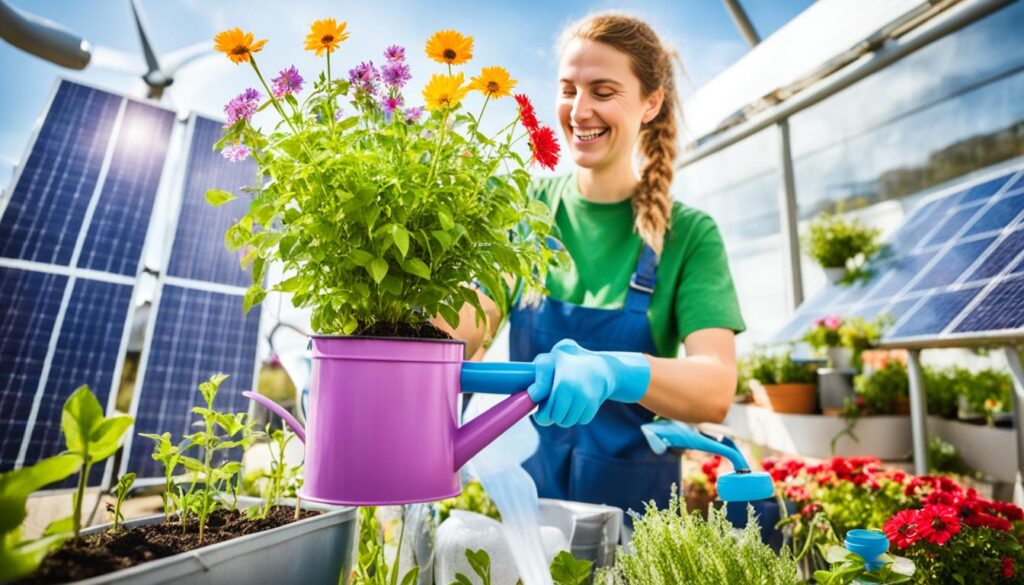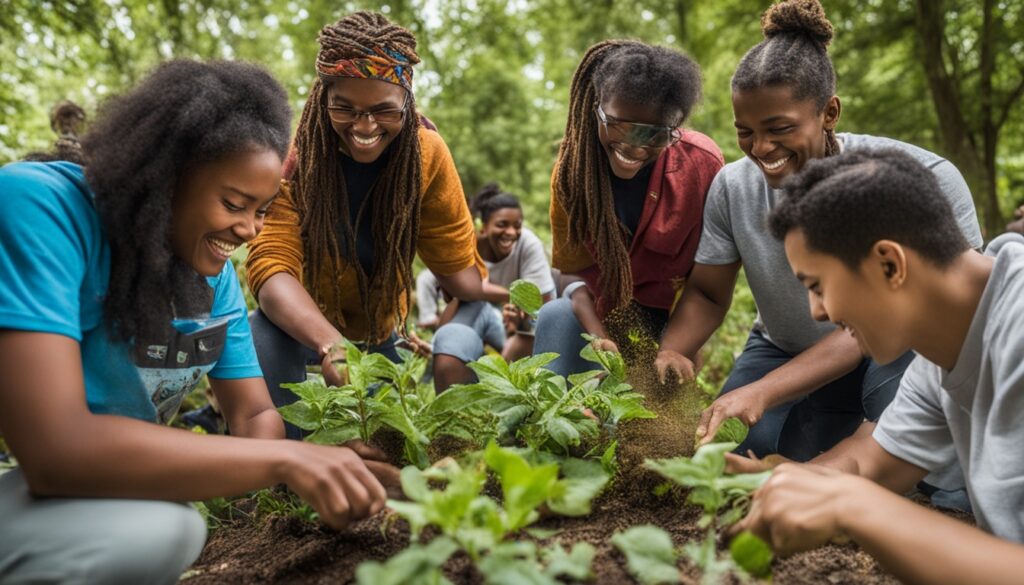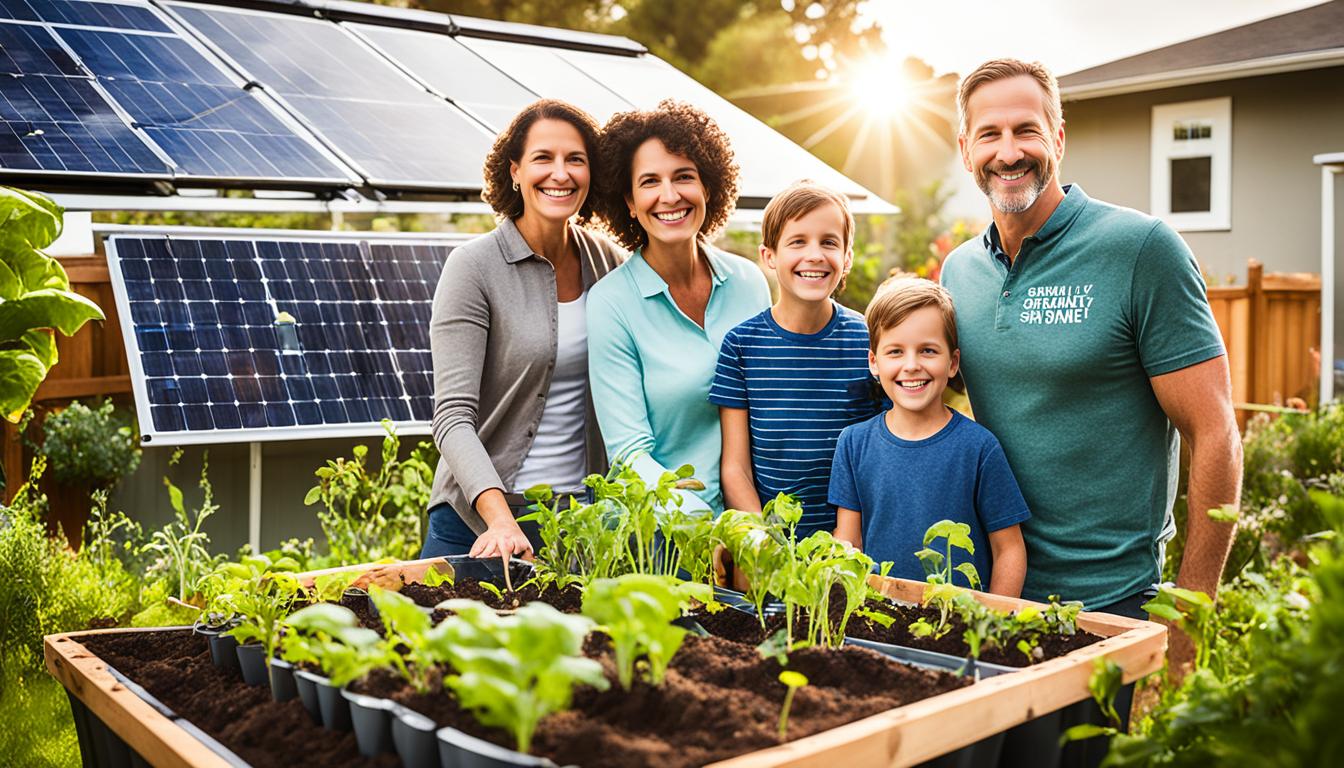Today, we face tough environmental challenges. Education is key to motivating people across the United States to live more sustainably. This article shows how teaching can help individuals and communities choose eco-friendly options. It aims to lead us towards a greener future1. We’ll look at why sustainability education matters and how it connects us with nature. Also, we’ll explore how teaching the balance of environment and society can prepare us for changing times.
Our world is at a turning point. The call to live sustainably is very strong1. Schools, local groups, and movements are stepping up. They’re encouraging us to use more eco-friendly ways and aim for a sustainable future1. Through special programs, learning by doing, and working together, they’re making us leaders of positive change. This helps in building sustainable communities that live in peace with the Earth.
Key Takeaways
- Sustainable living is crucial for addressing pressing environmental challenges
- Education plays a vital role in inspiring communities to adopt eco-friendly practices
- Innovative educational initiatives foster sustainable life skills and respect for the planet
- Collaborative efforts among institutions, organizations, and communities drive sustainable change
- Preparing students for environmental challenges and green careers is essential for the future
The Importance of Sustainability Education
Sustainability education is key for creating eco-friendly citizens of the future2. It makes students more aware of their environment and teaches them to take care of the planet2. For example, through projects like the Urban Agriculture Lab by Spark-Y, they can see how the planet’s health affects daily life2.
Environmental Awareness and Responsibility
This kind of learning shows how social, environmental, and economic issues are all connected2. It gives students the tools to make choices that help the planet2. By telling them success stories, teachers keep the focus positive. This encourages students to live more sustainably2.
Hands-On Learning for Real-World Impact
Hands-on learning lets students work with nature and its products2. They see first-hand how their actions impact the world2. As they share ideas and work in groups, students feel less overwhelmed and more ready to help2.
- Higher education in sustainability readies students for big challenges2.
- Teaching sustainability topics in various subjects encourages different learning methods2.
- The serious problems of our planet can sometimes make students feel too stressed to act2.
- By working in teams and discussing, students better connect with the subject and reduce stress2.
- When students analyze data themselves, it helps them fully grasp environmental issues2.
| Sustainability Education Research | Key Findings |
|---|---|
| Using ESG data can change how companies perform in terms of the environment and society3 | Sweden’s efforts in teaching sustainability in higher education were studied3 |
| Pakistan has faced challenges in changing its educational modules for sustainability3 | Learning about climate change can be done through art3 |
| A new tool helps make the shift to a circular economy easier3 | Factors that aid sustainability entrepreneurs in higher education were examined3 |
“1987: The United Nations defined sustainable development as meeting present needs without compromising future generations’ ability to meet their needs.”2
Interdependence Between Humans and the Environment
The link between people and the environment is crucial. Our world provides everything humans need to live4. Trees give us wood, food, and oxygen. The sea helps control weather and makes over half the world’s oxygen4. Yet, human actions like cutting down forests and polluting the oceans harm these ecosystems. It upsets the balance of life on Earth5.
Teaching about sustainability is key. It helps students see how tightly humans and nature are connected4. Through this, they learn the importance of natural resources and ecosystems. This wisdom can lead to more respect for the Earth. Also, it drives a want to protect it for those who come after us6.
| Key Findings | Implications |
|---|---|
| Current economic growth trends will need five times more resources by 20504. | This large-scale resource use harms our planet and future well-being. |
| Almost half of Brazil’s Cerrado has been ruined for farming, hurting its biodiversity and climate efforts5. | These changes hurt the environment, reduce wildlife, and push climate change, showing the urgent need for better land use5. |
| By 2050, the world will have 9.7 billion people, needing 54% more food and 56% more energy5. | We have to come up with solutions that meet human needs while keeping the planet safe5. |
The INHERIT project focuses on making environments that keep us healthy, solve environmental problems, and fight health differences4. When we see how humans and nature need each other, we can find smart ways to support both. This could lead to a better life for everyone6.
“Protecting nature and meeting human needs for water, food, and energy are not mutually exclusive goals but can be achieved concurrently through smart energy, water, air, health, and ecosystem initiatives.”5
It’s vital we acknowledge the strong link between our well-being and the Earth’s health6. Understanding this encourages actions that help both people and the planet thrive. Together, we can ensure a future that’s both sustainable and bright.
Balancing Environment and Society
It’s vital to blend efforts for a safe environment and a thriving society7. Today, climate change, uneven wealth, and unfairness are the big issues impacting our world. They are hard to beat alone, so we need strong, green communities7. When we teach how to do business the green way, we’re not just teaching a lesson; we’re creating changemakers.
Looking at Spark-Y’s approach shows how. Their LEEF courses mix business skills with a green twist. They let students spot green-acting firms and start their own eco-friendly ventures7. This knowledge helps them juggle what’s good for the planet with people’s needs and proper management, aiming for a greener tomorrow8.
Young people are caring more about where their money goes. Learning this early will make them want to change how companies are run8. Having clear ways to show how eco-friendly and fair a company is can make a big difference. It builds trust and shows they are serious about doing good for Earth8.
| Sustainability Indicator | Description |
|---|---|
| Conformity to International Sustainable Rules | Alignment with global sustainability frameworks and guidelines |
| Materials Performance | Efficient and responsible use of materials |
| Environmental Effects | Minimizing negative environmental impact |
| Supply Chain Considerations | Sustainable practices throughout the supply chain |
| Organizational Sustainable System | Comprehensive integration of sustainability into business operations |
Teaching eco-friendly business practices and ESG principles is powerful78. In doing so, we’re not just inspiring a few – we’re touching entire communities. This includes encouraging practices that are good for the environment9.
“Sustainable development is development that meets the needs of the present without compromising the ability of future generations to meet their own needs.”7
Educational Initiatives Inspire Communities to Adopt Sustainable Living Practices
Innovative education efforts are making communities choose green living methods10. These local projects are key in pushing forward green plans10. They teach and encourage people to lead the way in change.
Spark-Y is an example, providing real-life green projects and internships10. They let students take part in growing microgreens, creating aquaponic systems, and learning about their green effects10. This way, people understand sustainability and feel ready to take action in their areas.
These lessons go beyond just personal actions, inspiring big community changes10. It’s critical that local areas take the lead in green efforts to meet big eco, social, and economy goals10. This builds a stronger community and encourages working together. Also, having access to data and new tech helps make smarter green choices for the future.
Communities are doing amazing renewable energy projects, like solar and small water power11. They also plant trees, support green policies, and get involved as volunteers11. This active role is shaping better, eco-friendly living areas.
By encouraging eco-friendly living through education, locals cut down on their green harm and feel more involved in their joint futures10. As more get inspired by these lessons, the effect reaches far and wide, helping transform cities and more.
“Empowering local communities to lead sustainable development efforts is crucial for achieving long-term environmental, social, and economic goals.”
Developing Sustainable Life Skills
Sustainability education is more than teaching facts. It helps students learn practical, eco-friendly skills. These skills help them make positive changes in their daily lives. They learn to grow food, save resources, and pick green products12.
This kind of learning also opens doors to great careers in sustainability. Fields like biology and renewable energy lead to rewarding jobs in environmental protection12. Starting early, these educational programs inspire students to choose paths that make the planet better12.
Preparing Students for Green Careers
The UN Decade of Education for Sustainable Development aimed for a greener future through learning13. This movement covers not just nature but also helps fight poverty and promotes fairness13. It gets students ready for jobs that tackle big challenges in a smart way.
| Sustainability Metric | Ecological Village Performance |
|---|---|
| Increased access to green spaces | 14 |
| Reduced stress levels | 14 |
| Participation in physical activities | 14 |
| Communal meals and activities | 14 |
| Waste reduction | 14 |
| Renewable energy generation | 14 |
| Cost savings | 14 |
| Sustainable living education | 14 |
| Community engagement | 14 |
| Ecological footprint reduction | 14 |
| Advocacy for sustainability | 14 |
The numbers prove that living in ecological villages makes difference-makers. This experience encourages them to choose careers that help keep the Earth safe. It connects their jobs with making the planet better14.
“Sustainability education is about more than just facts. It’s about giving students the power to change the world. With practical skills, we prepare them for a better future, even as things change fast.”
Fostering Respect for the Planet
Nurturing a deep environmental respect and sustainability mindset is key for our planet’s well-being. Programs in sustainability education are important. They breed a love for nature and teach students how to be active in conservation efforts.
These programs offer a full look at our Earth’s history and its functions. They teach why conservation is a must. Hands-on activities like making paper help students see why we must use our natural resources wisely15.
Besides classroom work, these education initiatives help teachers too15. They get access to lots of tools. This includes apps, videos, books, and more. Such resources make adding environmental education to their lessons easy15.
This education also puts a lot of focus on STEM. It helps students get a deep scientific view of nature. For example, measuring trees and learning about Pi all connect to how we see the planet15.
“Respect for the environment is not just a personal choice—it’s a collective responsibility that shapes the future of our planet.”
Starting early helps students get into the habit of being eco-friendly16. These lessons encourage them to waste less and protect the environment. This mix of learning and doing could really stick with them. It could shape their choices for life to help save the planet16.

The work in promoting environmental respect is crucial. By shaping students to care for our planet, these programs prepare us for a better tomorrow. They make sure we have people who are informed, care about the Earth, and take action to keep it safe17.
Future Preparation and Adaptation
Environmental adaptation and climate change are big challenges today. Sustainability education is crucial. It helps students learn how to take care of our planet in a changing world. They study self-sufficiency, science, and conservation. This helps them become future leaders and scientists18.
Addressing environmental adaptation and future sustainability is super important. By 2050, emissions from rich cities could double unless we act fast. We need to cut these emissions by two-thirds by 203019. Sustainability education teaches students how to come up with new ideas. For example, they can learn about using solar power to cut carbon in homes19.
Sustainability education isn’t just theories. It’s about doing things and gaining skills, too. Students can learn to use smart thermostats to use less energy or try out energy-saving light bulbs. These steps can make a real impact in their local areas19.
Equipping Students for Environmental Changes
The effects of climate change are getting worse. Sustainability education helps students prepare and respond. They learn about insulation, efficient boilers, and clean energy options19.
This type of education also shows the bond between people and nature. Students realize how important ecosystems are. They feel a duty to take care of the earth. This motivates them to fight against climate change and help our planet20.
Sustainability education is more than a good thing to have. It’s a must. It teaches students how to deal with environmental challenges. This way, we prepare them to make the world greener and stronger20.
“The world is witnessing one of the largest climate protests in history sparked by a 16-year-old, resonating across 160 countries through the efforts of children and young people.”20
The future of our planet is in young people’s hands. Sustainability education is key. It opens their eyes to environmental adaptation and fighting climate change. It gives them the power to create a better, more green future181920.
Community Engagement and Social Learning
Sustainability education isn’t just about learning facts. It’s also about getting involved with your community and learning together. When students work on real projects, they team up with friends. They exchange ideas and come up with plans to help the planet21. This way of working not only makes learning fun. It also helps students feel they can really make a difference for a green future in their neighborhoods21.
Taking part in sustainability education has lots of well-known perks22. For instance, students might tackle local issues with what they learn in class. This is called service learning and it’s becoming more popular on school campuses22. It helps students succeed in their studies, grow as people, and change their communities for the better2122.
Involvement with the community is also key for getting local officials to make green choices and for making democracies stronger21. Today, with the growth of online democracy, more people can join in decisions about the environment21. This move to virtual meetings comes with both hurdles and chances, providing a new path for students to lead change in their areas21.
“Community engagement is not just about imparting knowledge – it’s about empowering people to become active stewards of their local environment and catalysts for sustainable change.”
Teaching students about community and sustainability makes them care more about Earth. This kind of learning doesn’t just focus on books. It gets students out there, working together and making a real difference2122. This approach to education is all about preparing young people to solve the problems our planet faces21.

Programs like Colorful Communities are making a big difference. By the end of 2023, they’ll have given $13.8 million to support green education23. These efforts strengthen schools’ dedication to teaching about sustainability. They encourage students to be leaders in their communities and to care for the environment, creating a new wave of green champions21.
Integrating Sustainability Into Curriculum Standards
Sustainability education needs to reach all students by fitting into school plans everywhere24. But a study found U.S. teachers know this is key, yet often it’s not part of their teaching24. The Smithsonian Science Education Center is helping close this gap. They offer training and tools, like the Smithsonian Science for Global Goals program, for free24.
Supporting Teachers in Environmental Education
Helping teachers deliver strong green lessons makes sure kids everywhere learn about being green24. Back in 2002, the UN made a special time (2005-2014) to focus on this, because education is huge for going green24. They set out 17 goals, and Goal 4 is about making school good for everyone, helping people learn throughout their lives24.
The UN sees schools as hubs for good changes, and colleges have stepped up to help achieve the goals through sustainability projects24. Programs in science and tech teach students what they need for modern jobs24. A good STEM education can cut down poverty, boost economies, and make democracies stronger24.
Colleges are getting creative in teaching green ways so students can really change the world24. The University of Leeds wants to be known for teaching and learning in ways that help the planet25. They work together with LUNSHE to support education that focuses on a sustainable future25.
The University of Washington helped Rwanda’s Health Minister find ways to make cooking cleaner. This cut down on sickness from pollution in people’s homes26. The UN’s goals stress that good school for all is key, pushing for learning that helps the planet26. They aim for everyone to learn how to keep development green26.
By adding green lessons to all school plans, and helping teachers with what they need, students can do big things for the planet. They’ll be ready to make their areas and the world better places for everyone.
Inspiring Youth to Become Agents of Change
Sustainability education teaches students knowledge and skills. It also motivates them to lead change in the world27. For instance, youth-led efforts like “Fridays for Future” have focused global talks on climate change27. Also, groups like the Global Youth Biodiversity Network have helped create key environmental policies27. Hands-on programs show students their role in making a difference through learning by doing27.
Programs like the one at Spark-Y show the power of practical learning. After being part of Spark-Y, 94% of students felt they could make a big change, up from 41%27. Encouraging this belief helps create a new wave of eco-warriors and thinkers. Together, they aim for a planet-friendly future27. For example, the “Save the Beach” project in the Maldives has helped protect the shores and reefs. And the Arab Youth Council for Climate Change supports young people in finding creative and green solutions27.
Programs that partner with young people often do better at getting others involved28. And when youth have a say in decisions, the choices are more likely to be supported and last a long time28. True youth engagement means treating them as equals in important discussions. This approach helps them grow their understanding and care for the community28.
The Guided Projects by Student Energy offer help for eco-ventures led by youth27. Groups like HHS/ASPE and Youth Engaged 4 Change provide tools and chances for young people to step up28. These investments in our future changemakers encourage them to lead the way to a more eco-friendly future2728.
The crises of climate change and nature loss make it key to back our upcoming leaders27. 16% of the world’s population are young people. Their energy and fresh ideas are vital for a greener tomorrow2728.
| Youth-Led Sustainability Initiatives | Key Achievements |
|---|---|
| Fridays for Future | Placed climate change at the heart of global policy discussions27 |
| Global Youth Biodiversity Network | Contributed to shaping the Global Biodiversity Framework27 |
| Save the Beach (Maldives) | Conserved and preserved beaches and reefs27 |
| Arab Youth Council for Climate Change | Supports youth climate action and develops sustainable solutions27 |
| Student Energy’s Guided Projects | Provides financial and technical assistance to youth-led initiatives27 |
By turning to our youth as allies in critical decision-making, we help them see their own power and potential. As the planet moves towards sustainability, investing in education and empowering our future leaders is key. It’s vital for tackling global issues and making the world a better place for everyone2728.
“A child born in 2020 is twice as likely to experience wildfires, 2.6 times more prone to droughts, 2.8 times more exposed to river floods, and 6.8 times more susceptible to heat waves than someone born in 1960.”27
The UK’s bold climate goals highlight the need to involve our youth in green projects29. By educating over 16 million people, the UK seeks to spark action for a sustainable future29. Empowering youth to make a difference is crucial for achieving these targets and leaving a positive impact for future generations272829.
Conclusion
Educational projects are key in teaching us to live sustainably30. They help students learn by doing and understand the importance of our planet. This way, kids get the tools to choose eco-friendly options and make a difference31. In a time when our earth is in danger, we must teach about sustainability in schools and towns everywhere in the U.S32.. If we invest in young people and support their actions, we pave the way for a better future for all.
Reminder sessions show us why teaching about sustainability matters303132. They share how education can inspire change. By giving students knowledge and skills, we encourage them to help the planet. This is crucial for a sustainable tomorrow.
It’s time to make teaching about saving our environment a big deal303132. We need to act together and help the next generation save our earth. This is how we can tackle the big issues affecting our planet. Let’s prepare for a future where everyone can thrive.
FAQ
What is the role of education in inspiring sustainable living practices?
How can sustainability education develop environmental awareness and responsibility?
What are the benefits of hands-on learning experiences in sustainability education?
How does the relationship between humans and the environment influence sustainability?
What role does sustainability play in balancing environment, society, and the economy?
How can educational initiatives inspire communities to adopt sustainable living practices?
What sustainable life skills can students develop through education?
How does sustainability education foster respect for the planet?
How can sustainability education prepare students for future environmental changes?
What is the role of community engagement and social learning in sustainability education?
How can sustainability education be integrated into curriculum standards?
How can sustainability education inspire youth to become agents of change?
Source Links
- The Power of Community: Building Sustainable Neighborhoods
- Teaching Sustainability
- Sustainability in Education
- Encouraging and Enabling Lifestyles and Behaviours to Simultaneously Promote Environmental Sustainability, Health and Equity: Key Policy Messages from INHERIT
- The Science of Sustainability
- Promoting Sustainable Wellbeing: Integrating Positive Psychology and Environmental Sustainability in Education
- What is a Sustainable Community? – Institute for Sustainable Communities
- Environmental Sustainability: Definition, Examples & More | Inspire Clean Energy
- Pillars of Sustainable Development — Sustainable Review
- Empowering Local Communities for Sustainable Development.
- 10 Ways to Encourage Sustainability in Your Community
- How to Motivate People Toward Sustainability – Network for Business Sustainability (NBS)
- Education and sustainable development | Development Education Review
- The Top Benefits of Living in an Ecological Village – Spirala Ecovillage
- Top 10 Benefits of Environmental Education – Project Learning Tree
- 4 simple ways for governments to be more environmentally friendly
- FAQs – Earth Charter
- 10 Ways to Promote Sustainability on College Campuses
- 40 Ways to Be More Eco Friendly in 2024 | GreenMatch
- Why is Community Engagement Important? | Granicus
- What is Service Learning or Community Engagement?
- Community Engagement | PPG Sustainability Report
- Embedding Sustainability in Learning and Teaching: Lessons Learned and Moving Forward—Approaches in STEM Higher Education Programmes
- Embedding Sustainability in Teaching – Sustainability
- The Role of Universities in Advancing and Promoting Sustainability
- Youth as Agents of Change for a Sustainable Future
- Involving Youth in Positive Youth Development
- Sustainability and climate change: a strategy for the education and children’s services systems
- Sustainability in Events: Strategies for Reducing Waste and Promoting Eco-Friendly Practices – Personify
- College Students’ Role in Environmental Protection
- 7 Simple and Practical Strategies to Become a Sustainability Advocate: Making a Difference at Home…

